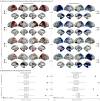This is a preprint.
ASSOCIATIONS BETWEEN EPILEPSY-RELATED POLYGENIC RISK AND BRAIN MORPHOLOGY IN CHILDHOOD
- PMID: 39868179
- PMCID: PMC11760683
- DOI: 10.1101/2025.01.17.633277
ASSOCIATIONS BETWEEN EPILEPSY-RELATED POLYGENIC RISK AND BRAIN MORPHOLOGY IN CHILDHOOD
Update in
-
Associations between epilepsy-related polygenic risk and brain morphology in childhood.Brain. 2025 Aug 14:awaf259. doi: 10.1093/brain/awaf259. Online ahead of print. Brain. 2025. PMID: 40811581
Abstract
Temporal lobe epilepsy with hippocampal sclerosis (TLE-HS) is associated with a complex genetic architecture, but the translation from genetic risk factors to brain vulnerability remains unclear. Here, we examined associations between epilepsy-related polygenic risk scores for HS (PRS-HS) and brain structure in a large sample of neurotypical children, and correlated these signatures with case-control findings in in multicentric cohorts of patients with TLE-HS. Imaging-genetic analyses revealed PRS-related cortical thinning in temporo-parietal and fronto-central regions, strongly anchored to distinct functional and structural network epicentres. Compared to disease-related effects derived from epilepsy case-control cohorts, structural correlates of PRS-HS mirrored atrophy and epicentre patterns in patients with TLE-HS. By identifying a potential pathway between genetic vulnerability and disease mechanisms, our findings provide new insights into the genetic underpinnings of structural alterations in TLE-HS and highlight potential imaging-genetic biomarkers for early risk stratification and personalized interventions.
Keywords: Imaging-genetics; brain structure; childhood; genetic risk; temporal lobe epilepsy.
Conflict of interest statement
POTENTIAL CONFLICTS OF INTEREST All authors declare no competing conflicts of interest.
Figures




References
-
- Epilepsy C. by H.-G W. for the I. C. on N. of. Mesial Temporal Lobe Epilepsy with Hippocampal Sclerosis. Epilepsia 45, 695–714 (2004). - PubMed
-
- Lin J. J. et al. Reduced Neocortical Thickness and Complexity Mapped in Mesial Temporal Lobe Epilepsy with Hippocampal Sclerosis. Cereb. Cortex 17, 2007–2018 (2007). - PubMed
-
- Keller S. S. & Roberts N. Voxel-based morphometry of temporal lobe epilepsy: An introduction and review of the literature. Epilepsia 49, 741–757 (2008). - PubMed
-
- McDonald C. R. et al. Regional neocortical thinning in mesial temporal lobe epilepsy. Epilepsia 49, 794–803 (2008). - PubMed
